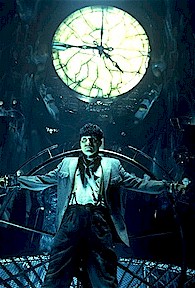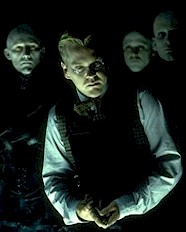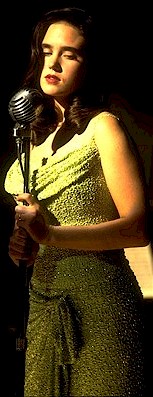|
Dark City |
||
|
John Murdoch: Rufus Sewell Directed by Alex Proyas. Written by Proyas, Lem Dobbs and David S. Goyer. Running time: 103 minutes. Rated R (for violent images and some sexuality). BY ROGER EBERT
Like ``Blade Runner,'' it imagines a city of the future. But while ``Blade Runner'' extended existing trends, ``Dark City'' leaps into the unknown. Its vast noir metropolis seems to exist in an alternate time line, with elements of our present and past combined with visions from a futuristic comic book. Like the first ``Batman,'' it presents a city of night and shadows, but it goes far beyond ``Batman'' in a richness of ominous, stylized sets, streets, skylines and cityscapes. For once a movie city equals any we could picture in our minds; this is the city ``The Fifth Element'' teased us with, without coming through. The story combines
science fiction with film noir--in more ways than we realize and more
surprising ways than I will reveal. Its villains, in their homburgs and
flapping overcoats, look like a nightmare inspired by the thugs in
``M,'' but their pale faces would look more at home in
They inhabit a city
of rumbling elevated streamlined trains, dank flophouses, scurrying
crowds and store windows that owe something to Edward Hopper's
``Nighthawks.'' In this city lives John Murdoch (Rufus Sewell), who
awakens in a strange bathtub beneath a swinging ceiling lamp, to blood,
fear and guilt. The telephone rings; it is Dr. Schreber The film will be the
story of Murdoch's flight into the mean streets, and his gradual
discovery of the nature of the city and the Strangers. Like many
science-fiction heroes, he has a memory shattered into pieces that do
not fit. But he remembers the woman he loves, or loved--his wife, Emma
(Jennifer Connelly), who is a torch singer with sad eyes and wounded
lips. There is a detective
after him, Inspector Bumstead (William Hurt). Murdoch is wanted in
connection with the murders of six prostitutes. Did he kill them? Like
the hero of Franz Kafka's The Trial, Murdoch feels so paranoid he hardly
knows. Rufus Sewell plays Murdoch like a man caught in a pinball
machine, flipped into danger every time it looks like the game is over. |
The story has
familiar elements made new. Even the hard-boiled detective, Murdoch's problem is that he has no way of knowing if his memories are real, if his past actually happened, if the women he loves ever existed. Those who offer to help him cannot be trusted. Even his enemies may not be real. The movie teasingly explores the question that babies first ask in peek-a-boo: When I can't see you, are you there? It's through that game that we learn the difference between ourselves and others. But what if we're not there, either? The movie is a
glorious marriage of existential dread and slam-bang action.
Is the film for teenage boys and comic book fans? Not at all, although that's the marketing pitch. It's for anyone who still has a sense of wonder and a feeling for great visual style. This film contains ideas and true poignance, a story that has been thought out and has surprises right to the end. It's romantic and exhilarating. Watching it, I realized the last dozen films I'd seen were about people standing around, talking to one another. ``Dark City'' has been created and imagined as a new visual place for us to inhabit. It adds treasure to our notions of what can be imagined. Copyright © The Sun-Times Company
|
|
 ``Dark City'' by
Alex Proyas is a great visionary achievement, a film so original and
exciting, it stirred my imagination like ``Metropolis'' and ``2001: A
Space Odyssey.'' If it is true, as the German director Werner Herzog
believes, that we live in an age starved of new images, then ``Dark
City'' is a film to nourish us. Not a story so much as an experience, it
is a triumph of art direction, set design, cinematography, special
effects--and imagination.
``Dark City'' by
Alex Proyas is a great visionary achievement, a film so original and
exciting, it stirred my imagination like ``Metropolis'' and ``2001: A
Space Odyssey.'' If it is true, as the German director Werner Herzog
believes, that we live in an age starved of new images, then ``Dark
City'' is a film to nourish us. Not a story so much as an experience, it
is a triumph of art direction, set design, cinematography, special
effects--and imagination. ``The Cabinet of
Dr. Caligari''--and, frighteningly, one of them is a child. They are the
Strangers, shape-changers from another solar system, and we are told
they came to Earth when their own world was dying. (They create, in the
process, the first space vessel since ``Star Wars'' that is newly
conceived--not a clone of that looming mechanical vision.)
``The Cabinet of
Dr. Caligari''--and, frighteningly, one of them is a child. They are the
Strangers, shape-changers from another solar system, and we are told
they came to Earth when their own world was dying. (They create, in the
process, the first space vessel since ``Star Wars'' that is newly
conceived--not a clone of that looming mechanical vision.)
 (Kiefer
Sutherland), gasping out two or three words at a time, as if the need to
speak is all that gives him breath. He warns Murdoch to flee, and indeed
three Strangers are in the corridor, coming for him.
(Kiefer
Sutherland), gasping out two or three words at a time, as if the need to
speak is all that gives him breath. He warns Murdoch to flee, and indeed
three Strangers are in the corridor, coming for him.
 And he remembers ... Shell Beach? Where was that? He sees it on a
billboard and old longings stir.
And he remembers ... Shell Beach? Where was that? He sees it on a
billboard and old longings stir.
 his eyes
shaded by the brim of his fedora, seems less like a figure from film
noir than like a projection of an alien idea of noir. Proyas and his
co-screenwriters, Lem Dobbs and David S. Goyer, use dream logic to
pursue their hero through the mystery of his own life. Along the way,
Murdoch discovers that he alone, among humans, has the power of the
Strangers--an ability to use his mind in order to shape the physical
universe. (This power is expressed in the film as a sort of transparent
shimmering projection, aimed from Murdoch's forehead into the world, and
as klutzy as that sounds, I found myself enjoying its very audacity:
What else would mind-power look like?)
his eyes
shaded by the brim of his fedora, seems less like a figure from film
noir than like a projection of an alien idea of noir. Proyas and his
co-screenwriters, Lem Dobbs and David S. Goyer, use dream logic to
pursue their hero through the mystery of his own life. Along the way,
Murdoch discovers that he alone, among humans, has the power of the
Strangers--an ability to use his mind in order to shape the physical
universe. (This power is expressed in the film as a sort of transparent
shimmering projection, aimed from Murdoch's forehead into the world, and
as klutzy as that sounds, I found myself enjoying its very audacity:
What else would mind-power look like?) Toward the
end, there is a thrilling apocalyptic battle that nearly destroys the
city, and I scribbled in my notes: ``For once, a sequence where the fire
and explosions really work and don't play just as effects.'' Proyas and
his cinematographer, Dariusz Wolski, capture the kinetic energy of great
comic books; their framing and foreshortening and tilt shots and
distorting lenses shake the images and splash them on the screen, and
it's not ``action'' but more like action painting.
Toward the
end, there is a thrilling apocalyptic battle that nearly destroys the
city, and I scribbled in my notes: ``For once, a sequence where the fire
and explosions really work and don't play just as effects.'' Proyas and
his cinematographer, Dariusz Wolski, capture the kinetic energy of great
comic books; their framing and foreshortening and tilt shots and
distorting lenses shake the images and splash them on the screen, and
it's not ``action'' but more like action painting.
 Proyas directed ``The
Crow'' (1994), the visually inspired film that was almost doomed when
its star, Brandon Lee, was killed in an accident. I called that film
``the best version of a comic book universe I've seen,'' but ``Dark
City'' is miles beyond it. Proyas' background was in music videos,
usually an ominous sign, but not here: His film shows the obsessive
concentration on visual detail that's the hallmark of directors who make
films that are short and expensive. There's such a wealth on the screen,
such an overflowing of imagination and energy. Often in f/x movies the
camera doesn't feel free because it must remain within the confines of
what has been created for it to see. Here we feel there's no limit.
Proyas directed ``The
Crow'' (1994), the visually inspired film that was almost doomed when
its star, Brandon Lee, was killed in an accident. I called that film
``the best version of a comic book universe I've seen,'' but ``Dark
City'' is miles beyond it. Proyas' background was in music videos,
usually an ominous sign, but not here: His film shows the obsessive
concentration on visual detail that's the hallmark of directors who make
films that are short and expensive. There's such a wealth on the screen,
such an overflowing of imagination and energy. Often in f/x movies the
camera doesn't feel free because it must remain within the confines of
what has been created for it to see. Here we feel there's no limit.
